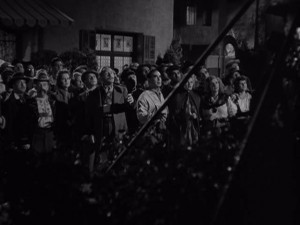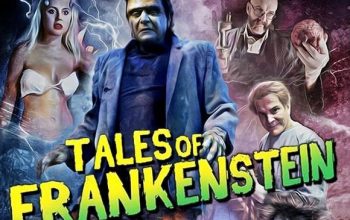Frankenstein Meets the Wolfman – 1943
This is a dull movie and kind of pointless, and yet its historical importance is undeniable. The central idea — taking two successful characters from different franchises and throwing them together — didn’t begin here. But by the same token I think this is where the idea started to appeal to the owners of properties, rather than just to creators. At the same time, similar ideas were being explored in the nascent comic book publishing business, and these days the idea of ‘take two characters that you love and make them fight’ is a dominant one at the box office.

In purely Frankensteinian terms, this film represents a big change for the Monster. Teaming him up here with the Wolf Man is just the start. Later, Dracula would be added, and the next thing you know the trio become inseparable in the public mind. There are a lot of iterations of this trio, whether as heroes, villains or comic foils. A lot. And it all starts here.
Which doesn’t make a lot of sense, if you think about it. Dracula and the Wolf Man at least come from similar mythological roots. Frankenstein comes from a completely different tradition, powered by pseudoscience rather than black magic. But then, that’s the trouble with a lot of these team-up stories. Thor and Iron Man, Jason and Freddy Kruger, Superman and Wonder Woman… these characters come from fictional worlds which are underwritten by completely different sorts of logic. When they come together… Well, I guess when they come together we just ignore the contradiction, so long as the fight scenes are suitably awesome.
So, the movie: Two grave robbers break into the Talbot family tomb. One discovers dried wolfsbane covering the grave of Lawrence Talbot (Lon Chaney, Jr). They move it, and one recites the legend of the werewolf from the film The Wolfman:
Even a man who is pure of heart and says his prayers at night
May become a wolf when the wolfsbane blooms and the moon is full and bright
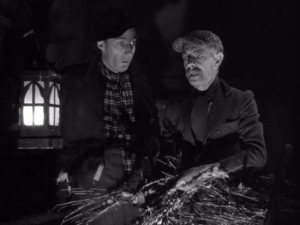
They try to steal Talbot’s jewellery, but in their meddling, the light of the moon falls on the body of Talbot. He comes to life and grabs one of the robbers. The other flees, dropping his torch as he runs.
A policeman with a weirdly indeterminate accent finds Talbot lying in the street, bleeding from a head wound. He’s taken to hospital, where he’s tended by Dr Mannering (Patrick Knowles). Dr Frank Mannering. Foreshadowing? Nah.
Talbot wakes up to explain that he doesn’t remember what happened. A police inspector (Dennis Hoey) asks him how he got ‘that skull fracture’ like a skull fracture is some sort of valuable contraband and Talbot should be ashamed to possess it.
The inspector learns that Lawrence Talbot is dead. This has no immediate impact on the story. In fact there’s quite a lot of padding here. Anyway, Talbot wakes again in his hospital bed, the light of the full moon streaming in through his window. He transforms into the Wolf Man, and attacks and kills a policeman.
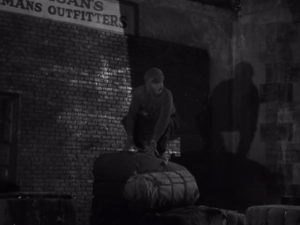
Talbot tells Dr Mannering that he killed a man. The doctor believes that Talbot is delusional. The Inspector turns up, demanding to know who Talbot really is, but is taken aback when Talbot confesses to being a murderous werewolf. Talbot demands that they check his grave, but is wrestled back to bed by hospital orderlies.
There’s some pointless discussion between the doctor and the inspector. In the end, they decide to go see Talbot’s tomb. They find out… well basically, they found out what we already knew. A local copper gives some backstory from The Wolf-Man. Mannering calls in and finds out that Talbot got out ofhis straightjacket and escaped.
Maybe that daring escape would have been more fun to watch than the exposition scene. Just saying.
Talbot finds Maleva (Maria Ouspenskaya), the old gypsy woman who gave him so much exposition in The Wolf Man. She is apparently in mainland Europe? Okay, I guess. Anyway, Talbot asks if she can help him die. She says no, but she’ll look after him, and take him to a man with the power to help him.
They go off — padding, padding — then they arrive in… Vasaria. Dun dun dun! In an inn, Maleva asks about Dr Frankenstein, while Talbot takes a shine to a young woman who works at the place. The innkeeper points out the ruins of a castle. Either this is Henry Frankenstein’s lab, now relocated to Vasaria and easily visible from town, or else the burned down ruins of Ludwig Frankenstein’s hospital, somehow transformed into a castle. The Innkeeper gives a vague Frankenstein backstory which could refer just as easily to Frankenstein or Ghost of Frankenstein, then kicks them out.
As they drive away, the full moon rises, and Talbot runs off and turns into the Wolf-Man. A large party of villagers brings a dead girl to town and wonder whether the Monster did it. But no, they say that it was an animal bite that killed the girl, and go off in pursuit of a howling wolf.
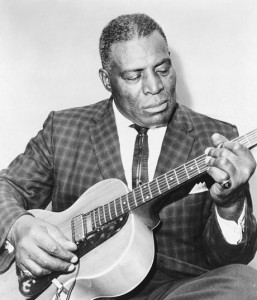
Naturally, this howling wolf turns out to be Talbot. There’s a chase and Talbot falls into the basement of the Frankenstein ruins. The angry mob finds Malvera, and take her back to town, vowing to make her confess. Oh, Vasarian angry mobs! Don’t you ever change.
Talbot wakes up in an icy cavern beneath the castle, and discovers the frozen body of the Monster (Bela Lugosi, clearly none too impressed with this bit of casting). Talbot frees the Monster to help him find Frankenstein’s records, but they are not the notes he is after. However, he does find a picture of Elsa Frankenstein and decides that she can help.
Elsa, you may recall, was the daughter of Ludwig Frankenstein in Ghost of Frankenstein. In this movie, the Mayor of Vasaria calls her ‘Baroness’, which is odd. If Wolf Frankenstein died, then his son Peter would take the title before it went to his niece Elsa. Besides, Elsa is here presented as an elegant aristocrat (or the Hollywood version of an elegant aristocrat, anyway), while she was presented more as a sort of middle-class ‘good girl’ in Ghost.
The Mayor (yes, is is Lionel Atwell, how did you guess?) tells Elsa of an offer to buy her father’s estate, coming from a Mr Taylor. Taylor is revealed to be Talbot. From memory, Talbot came from a wealthy Welsh family, but since he predeceased his father, I don’t see how he could have inherited. But it turns out that the sale was a lie, he just wants Elsa’s father’s records, so continuity problem averted. Elsa claims not to have the records.
The village breaks out into their annual Festival of the New Wine. So when they aren’t rioting, I guess the Vasarians entertain themselves by drinking drinking heavily? It explains a lot. There’s a musical number. No, really. Talbot and the Baroness sit at a table listening to it, but Talbot is freaked out by a lyric wishing him eternal life. He starts screaming at the singer.

Dr Mannering turns up. While Elsa is dancing with the Mayor, Mannering challenges Talbot, demanding that he return to England to be treated for his ‘madness’. Talbot tells him that he could help more by helping with his scheme. A Vasarian innkeeper overhears him talking about Frankenstein.
The Monster goes on the rampage again. A slow, half-hearted rampage. If you’ll recall, the Monster was supposed to have been blinded in the last episode. This fact isn’t mentioned here, but Lugosi still plays the Monster as if he’s blind, so he moves slowly and carefully for no adequately explained reason.
Talbot convinces the Monster to escape with him, while Elsa cosies up to Mannering. The angry mob responds to the Monster’s lackluster rampage with equal half-heartedness, deciding that the ruins of the castle are too spooky to storm.
Elsa is brought before the mob’s Standing Committee on What to Storm Next. She, Mannering and Malvera are interviewed. This goes as well as might be expected. Mannering says that if the Monster was created scientifically, then he can destroy it scientifically. The mob, lacking a better idea, agrees. Elsa, Mannering and Malvera go to Talbot in the ruins.
Elsa finds notes which reveal that the Monster has a lifespan ten times that of a normal human, unless its energy were drained off artificially by – get this – changing the poles from plus to minus. Science! Talbot realises that the evil energies from his body could also be drained away by Frankenstein’s equipment.
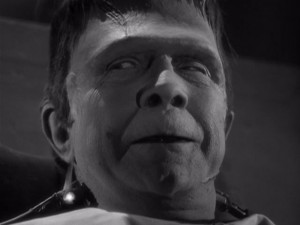
Mannering, a visionary gleam in his eye, begins reassembling the equipment. The angry mob considers deferring judgement. The innkeeper remembers the underground stream that runs the castle turbines…
You remember those? The castle turbines? You don’t? Well, rest assured that there were castle turbines and the innkeeper remembers them. He suggests redirecting the stream so that it doesn’t flow through the frozen, ice-filled caverns underneath the castle anymore, but instead floods the castle, drowning everyone. The Mayor rejects the idea. Atwill, you buzzkill!
Elsa begs Mannering to destroy the Monster and ignore Talbot, who she believes is deluded. She also warns him against becoming obsessed with his power. The Monster and Talbot are wired into the machine.
Mannering becomes obsessed with his power. D’oh! He reconnects the jumper cables so as to give his patient more energy, and restore him to full power. Elsa is woken by the sound of the energy going the wrong way, which I guess this is the ‘pea under the mattress’ for Frankensteins.
The noise also awakes the villagers — except for the innkeeper, who is already trying to blow up the dam. The full moon rises. Talbot transforms, Elsa screams. The Monster awakes and begins terrorising Elsa. Talbot escapes his bonds and fights the Monster. Elsa — having been deliberately betrayed by Mannering — clutches close to Mannering, trusting him to get her to safety. There’s a fight which is equal parts awesome and stupid. The dam explodes, and the monsters are washed away… Or is they, question mark.
First up, Frankenstein Meets the Wolf Man is mostly a Wolf Man movie. Nothing wrong with this. Lon Chaney Jr’s tortured, desperate monster is often the redeeming feature of the later Universal Monster Movies. The flip side of this is that the Monster gets virtually no characterisation. Is he still the malevolent version of the Monster with Ygor’s brain from the end of Ghost? Apparently, there are deleted scenes suggesting that he is, but there’s nothing in the finished film we see to suggest Ygor reigns in the membrane.
The film is scripted by Curt Siodmak, the writer of The Wolf Man and the creator of a lot of the ‘ancient legends’ in that movie – full moon, wolfsbane, silver weapons and contagious werewolf bites all come from Siodmak’s script, not European folklore as many assume. In this film, Siodmak adds immortality to the list of werewolf traits, but this didn’t catch on so well.
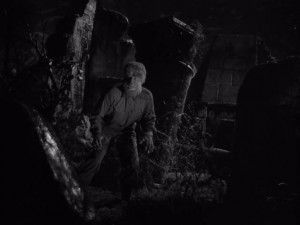
Where Siodmak’s script gets interesting is where he tries to find a way to combine the werewolf and Frankenstein stories. Well, yeah, interesting maybe isn’t the best word. What he does is pulls that neat trick that New Age types pull of using the word ‘energy’ to mean ‘basically anything’, so lycanthropy and Frankenstein science are just different (but interchangeable) ‘energies’.
But this isn’t as lazy as it seems. Mary Shelley deliberately avoided going into detail about Frankenstein’s process, but the implication is that Frankenstein’s work revolved around the concept of a life force or life energy – which was an actual serious concept in her lifetime, supported (albeit wrongly) by serious medical people.
The idea that the force that brings the Monster to life is electricity comes from James Whale’s Frankenstein. Whale possibly borrowed the idea from Metropolis and probably using it more because it was a cool visual than because it made sense. However, Frankenstein tells Waldman that his equipment works because he has tapped into a ray ‘beyond ultra-violet’.
Son of Frankenstein revised this to claim that Henry Frankenstein had accidentally tapped into cosmic rays in his experiment. Frankenstein Meets the Wolf Man goes back a step and uses some generic form of energy. House of Dracula picks up on some later medical breakthroughs as window dressing, to bridge the gap between fantastic problems and SF solutions, but doesn’t get into the hows and whys of Frankenstein.
And later, of course, DNA is discovered and a whole lot of later Frankenstein films just work on the common SF principle that ‘DNA’ stands for ‘magical life-essence’, to the detriment of Frankensteinian pseudoscience.
So let’s talk about the legacies of Frankenstein Meets the Wolf Man. One, movie crossovers. The crappy fight scene here is the grandfather of the crappy fight scenes in Superman Versus Batman: Dawn of Boredom. And two, fudging the way movies work so that characters who really shouldn’t exist in the same sort of fictional universe can and do. The next two Universal Frankenstein movies – House of Frankenstein and House of Dracula also play with these ideas. But while all three of these films play with the notion of integrating these characters, they never quite pull it off. The three main characters never really interact enough. Their stories seem to run parallel within each movie, rather than playing off each other. This changes in the very final Universal Frankenstein movie – the imaginative and underappreciated Abbott and Costello Meet Frankenstein.
